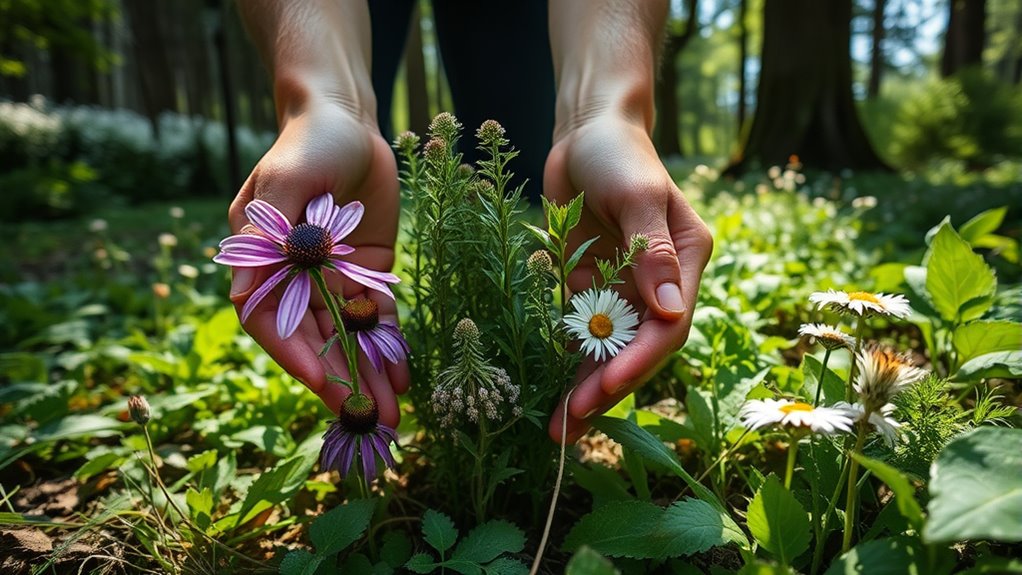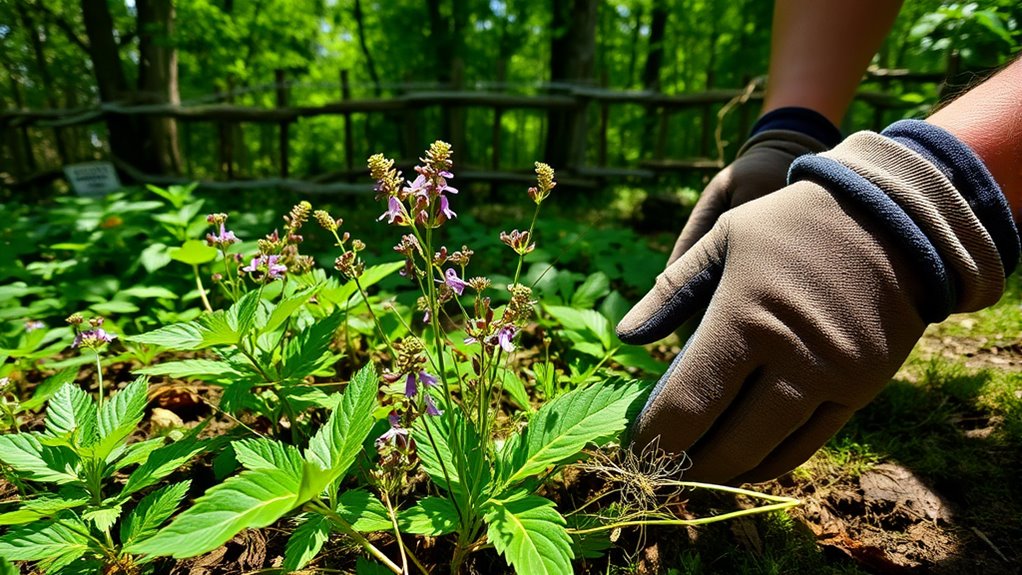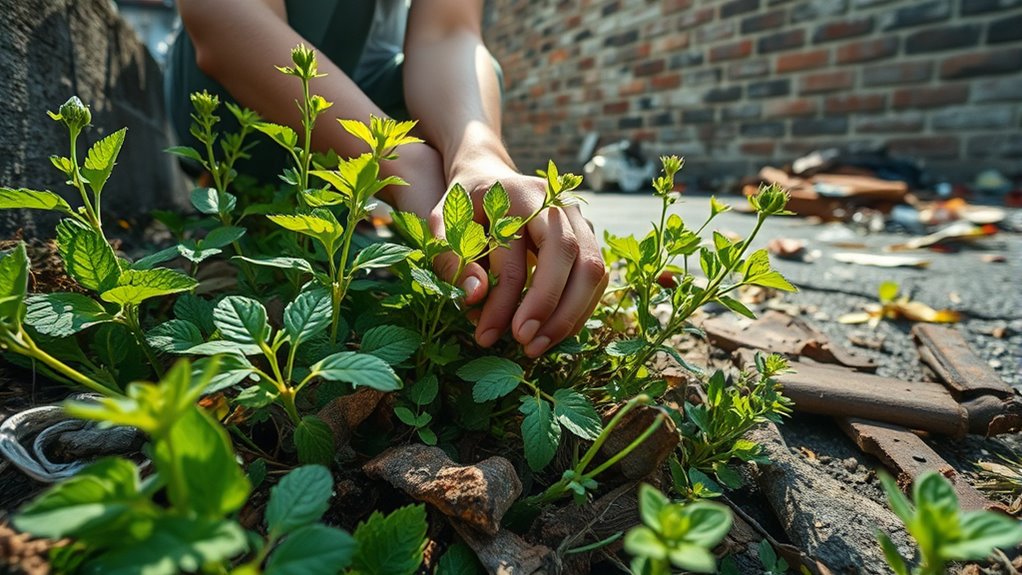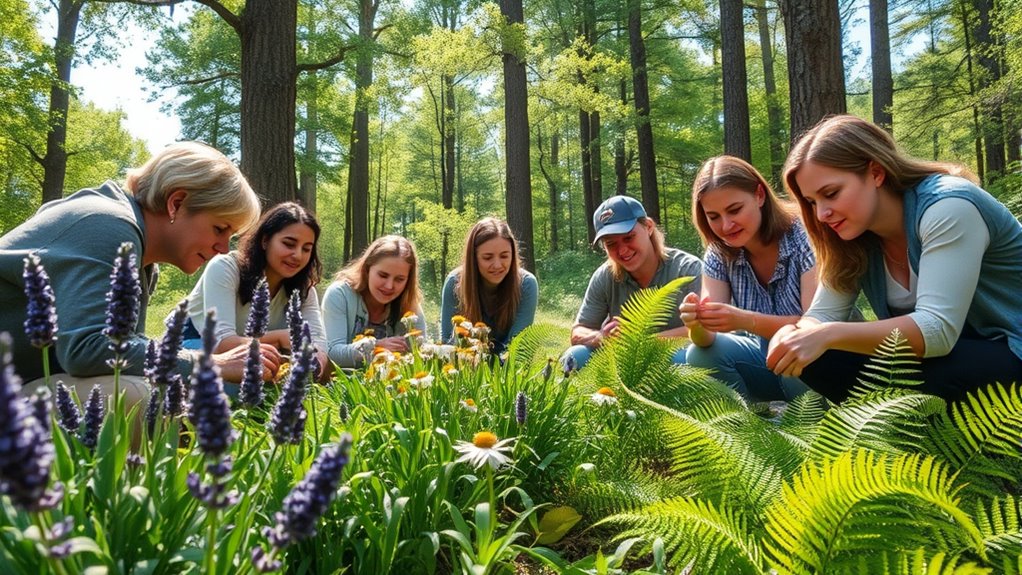To forage for medicinal herbs, focus on abundant, invasive, or nonnative plants like chickweed, lamb’s quarters, and dandelions that thrive in urban and disturbed areas. Learn to accurately identify safe species and avoid toxic look-alikes such as poison hemlock or digitalis. Practice sustainable harvesting by taking only what you need, leaving plants intact, and respecting land rules. If you’re curious about honing your skills and ensuring safe, eco-friendly foraging, there’s much more to explore.
Key Takeaways
- Identify safe, abundant, non-native plants like chickweed, plantain, and lamb’s quarters in urban or disturbed environments.
- Harvest sustainably by taking only necessary parts and avoiding endangered or protected species.
- Learn to distinguish medicinal herbs from toxic look-alikes such as poison hemlock or digitalis.
- Prioritize foraging in pollution-free areas like parks, gardens, or designated zones with proper permissions.
- Use trusted guides, community resources, and courses to build identification skills and ensure responsible harvesting.
Recognizing Abundant and Nonnative Plants for Foraging

To forage safely and sustainably, you need to recognize abundant nonnative plants that grow readily in your area. These invasive species, like chickweed, lamb’s quarters, and plantain, thrive in disturbed and urban environments, making them accessible urban greens for wild foraging. Learning plant identification helps distinguish edible herbs and medicinal weeds from toxic look-alikes. Focus on abundant populations to ensure sustainable harvesting, taking only what you need without harming the plants or their ecosystem. Using reliable field guides and regional plant lists is essential for accurate identification. Many nonnative weeds grow in “in-between” spaces such as sidewalks, gardens, and abandoned lots, providing convenient sources for foraging. Recognizing these plants and understanding their role promotes eco-friendly harvesting and helps maintain healthy ecosystems. Incorporating natural elements into your foraging practices can enhance your connection to the environment and support a calming, mindful experience. Being aware of plant distribution patterns helps identify optimal foraging locations and avoid overharvesting in sensitive areas. Additionally, understanding the growth habits of these plants can assist in sustainable harvesting practices while supporting local biodiversity. Exploring plant growth cycles can also inform the best times for harvesting and ensure plant populations remain resilient. Moreover, staying informed about conservation considerations ensures that foraging activities do not negatively impact native or endangered species.
Ethical and Sustainable Harvesting Practices

When foraging, you should always respect plant populations by harvesting only abundant, non-endangered species and avoiding rare ones. Take just enough to use, leaving reproductive parts intact to support regrowth. Following local guidelines and obtaining permission when needed guarantees your practices remain ethical and sustainable. Additionally, being aware of harmful plants like Jacob’s Ladder can help you avoid inadvertently introducing toxins into your foraged herbs. Recognizing the importance of angel numbers in understanding spiritual guidance can also enhance your connection to nature and your overall foraging experience. Developing a demo reel of your foraging success stories can also inspire others and showcase your knowledge. Incorporating sustainable harvesting techniques ensures you maintain healthy plant populations for future foragers. Understanding the role of native plant species in ecosystems can further improve your sustainable harvesting practices.
Respect Plant Populations
Practicing respectful and sustainable harvesting is essential to preserving wild plant populations. By applying foraging ethics, you help ensure plant conservation and support plant sustainability. Focus on harvesting abundant, widespread plants to prevent overharvesting and protect native plants. Avoid taking from rare, endangered, or protected species by consulting resources like United Plant Savers or government listings. When gathering, take only what’s necessary—such as a stem or part of the root—leaving reproductive parts intact to promote regeneration. Prioritize collecting from invasive, non-native, or plentiful plants in disturbed or urban areas to minimize impact on native ecosystems. Always practice ethical gathering by obtaining permission on private land and reducing habitat disturbance, ensuring the health of wild plant populations for future generations. Understanding the geometric patterns present in plant structures can also inform sustainable harvesting practices. Additionally, recognizing the importance of plant reproductive cycles can help time harvests appropriately and promote healthy plant populations. Incorporating regenerative harvesting techniques can further enhance the sustainability of your foraging practices. Being aware of plant structure can help identify the best parts to harvest without damaging the plant. Moreover, understanding how nutrient distribution within plants influences growth can guide more effective and sustainable collection methods.
Follow Responsible Harvesting
Responsible harvesting guarantees that wild medicinal plants remain available for future generations while supporting healthy ecosystems. To practice sustainable harvesting, focus on plant identification to ensure you’re collecting the right species and avoiding poisonous look-alikes. Follow wildcrafting ethics by taking only a portion of the plant, leaving reproductive parts intact, and replanting roots when possible to promote plant abundance and habitat preservation. Always harvest from areas free of pollution and pesticides, prioritizing safe foraging sites like urban gardens or protected wild spaces. Check local regulations and obtain permission when harvesting on private land, respecting conservation efforts. By practicing these techniques, you’ll help maintain healthy populations of medicinal herbs and ensure their availability for years to come. Understanding the significance of dream symbols can also deepen your connection to nature and your environment, fostering a more mindful approach to foraging.
Navigating Legal and Property Considerations

Before foraging, verifying land ownership and securing permission is vital, as trespassing violations can lead to legal trouble. You should always confirm who owns the land and obtain permissions if it’s private property. Familiarize yourself with local, state, and federal regulations, since some public lands restrict or prohibit harvesting certain plants. Look for posted signs or designated foraging zones, especially in parks and protected areas, to guarantee you’re complying with rules and supporting conservation efforts. Pay close attention to property boundaries to avoid accidental trespassing or disputes. Some areas may restrict foraging due to pesticide use, contamination, or habitat protection, which affects both safety and legality. Staying informed helps you harvest responsibly while respecting land rights and legal boundaries. Additionally, being aware of local regulations can prevent unintended violations and promote sustainable foraging practices. Always consider the availability of medicinal herbs in your area to ensure responsible harvesting without depleting native populations. Proper knowledge of plant identification helps prevent the collection of endangered or toxic species, promoting ecological balance and safety. Moreover, understanding the best times to forage can optimize your harvest while minimizing environmental impact. Incorporating foraging ethics ensures that harvesting is done sustainably and respectfully towards the environment.
Identifying and Avoiding Toxic Look-Alikes

Since many toxic plants closely resemble edible herbs, it’s essential to learn how to distinguish them accurately. Poison hemlock and water hemlock are deadly look-alike plants that mimic safe wild carrots or parsley, risking severe poisoning. To avoid mistakes, focus on these key features:
Always verify plant ID carefully; deadly look-alikes like poison and water hemlock mimic safe herbs.
- Leaf shape and arrangement – note differences in leaf edges and stems.
- Flowers and seed pods – examine flower structures and seed details.
- Stem markings – check for distinctive markings or coloration.
Always cross-reference your plant identification using multiple trusted field guides or consult experienced foragers. Recognizing poisonous look-alikes like oleander or digitalis is critical for foraging safety, especially when plants resemble medicinal herbs. When in doubt, avoid harvesting ambiguous plants to prevent dangerous mistakes. Additionally, understanding the identification features of Glycolic acid can help in identifying safe versus unsafe plants during foraging. Familiarity with plant toxicity indicators can further enhance your ability to identify potentially harmful specimens.
Harvesting in Urban and Disturbed Environments

When harvesting in urban or disturbed areas, focus on safe zones like parks or vacant lots with clean soil. Learn to recognize common edibles such as chickweed and plantain, but always double-check to avoid toxic look-alikes. Be mindful of possible contamination and follow local rules to guarantee your foraging is both safe and responsible.
Safe Harvesting Zones
Ever wondered where to safely harvest medicinal herbs in urban or disturbed settings? Safe foraging zones are key for urban harvesting and sustainable wildcrafting. Look for areas with abundant wild plants, such as vacant lots or roadside edges, but avoid plants near roads, railroads, or power lines to reduce pollution risks. Always verify environmental safety by checking nearby land uses like farms or industrial sites.
To ensure ethical harvesting, remember:
- Harvest only abundant, non-endangered plants, leaving reproductive parts intact.
- Focus on areas with clear land use, avoiding contaminated zones.
- Follow local regulations and seek permission when necessary.
Recognize Urban Edibles
Have you noticed how many wild edible plants thrive in urban and disturbed areas? Urban edibles like dandelions, chickweed, and wild violets grow in sidewalks, parks, and abandoned lots. To forage safely, you must master plant identification, especially since invasive species like garlic mustard and lam’s quarters are common. Always check soil and plant health; avoid plants near roads or industrial zones to prevent pollution exposure. Sustainable harvesting ensures these wild plants remain available for future foragers. Urban foraging offers a chance to gather medicinal herbs in city landscapes, but caution is key. Recognize edible species and distinguish them from look-alikes to stay safe. Use this table as a quick guide:
| Plant Name | Habitat | Edibility & Notes |
|---|---|---|
| Dandelion | Lawns, disturbed soils | Edible leaves, roots, medicinal |
| Chickweed | Garden edges, parks | Nutritious, medicinal uses |
| Wild violets | Shaded areas | Edible flowers, leaves |
| Garlic mustard | Waste areas | Invasive, edible, sustainable |
| Lam’s quarters | Urban lots | Invasive, edible in moderation |
Minimize Contamination Risks
Are you aware of the contamination risks involved in harvesting medicinal herbs from urban or disturbed areas? When wild harvesting in these environments, you must prioritize plant safety and pollutant avoidance. To minimize risks, consider these steps:
- Avoid harvesting near roads, railroads, or power lines to prevent soil contamination from vehicle emissions and chemicals.
- Refrain from gathering plants from urban or industrial sites that may have pesticide or herbicide residues, ensuring pesticide-free herbs.
- Conduct soil testing or assess the land’s history before harvesting, and always wash plants thoroughly with clean water to reduce surface pollutants.
Following harvesting ethics and practicing caution in disturbed areas helps ensure your medicinal herbs are safe for use and free from harmful contaminants.
Building Confidence With Guided Resources and Community Support

Building confidence in medicinal herb foraging becomes much easier when you utilize guided resources and connect with supportive communities. Guided resources like online courses, field guides, and instructional videos offer clear, step-by-step instructions that enhance plant identification and teach sustainable harvesting techniques. Community support through forums, local foraging groups, and social media links you with experienced foragers who share tips, advice, and real-time feedback, boosting your foraging confidence. Participating in workshops or virtual classes provides hands-on practice and personalized guidance, making beginner-friendly herbs easier to identify and harvest safely. Access to curated educational resources simplifies learning, while engaging with these networks fosters motivation, accountability, and a shared purpose—ultimately helping you develop your herbal medicine skills with trust and ease.
Frequently Asked Questions
What Is the Number One Rule of Foraging?
The number one rule of foraging is to never harvest plants unless you’re absolutely sure of their identification. You need to be confident that what you’re gathering is safe and not toxic, which means using reliable field guides, consulting experts, and carefully observing plant features. This guarantees your safety, supports sustainable practices, and helps protect the environment. Always prioritize positive identification before collecting any wild plants.
What Is the Study of Medicinal Herbs Called?
Imagine walking through a lush forest, discovering plants that hold healing power — that’s herbalism in action. The study of medicinal herbs is called herbalism or phytotherapy. You identify, prepare, and use plants to promote health and treat ailments. By combining traditional knowledge with modern science, you gain a deeper understanding of how these herbs work. This fascinating field connects nature’s remedies with your well-being, making each discovery meaningful.
How Do You Harvest Medicinal Herbs?
When harvesting medicinal herbs, you should focus on only the healthy, mature parts like leaves, flowers, or roots at their peak potency. Use clean, sharp tools such as scissors or pruning shears to make precise cuts and minimize damage. Always identify the plant correctly to avoid dangerous look-alikes. Harvest sustainably by taking only what you need, and avoid areas near pollution or chemicals to keep your herbs safe and effective.
What Is the 1 3 Rule for Foraging?
Imagine walking through a lush, green forest, feeling the soft breeze as you carefully pick just a few herbs. The 1-3 Rule guides you to harvest no more than one-third of any plant, ensuring it can grow back strong. By doing this, you protect the plant’s future, support the ecosystem, and enjoy sustainable foraging. It’s about respecting nature while gathering what you need responsibly.
Conclusion
By mastering these foraging principles, you open a treasure trove of medicinal herbs that can transform your health and deepen your connection to nature. With careful identification, ethical harvesting, and community support, you’ll become a true botanical explorer—more attuned to the wild world than most. Remember, your foraging journey isn’t just about gathering plants; it’s about revealing nature’s boundless healing power—an adventure more profound than discovering a hidden universe right outside your door.










